
Is Solana A Good Investment In November 2025?
Crypto users often meet a great variety of currencies to choose from when deciding where to invest their money. Today we’ll discuss the investment potential of Solana (SOL), considering its history, main characteristics, and potential risks. Let’s start!
Solana As An Investment
Solana (SOL) is considered a good investment option due to its fast, scalable blockchain and low transaction fees. With the ability to process over 65,000 transactions per second and a unique Proof of History (PoH) consensus mechanism, Solana stands out for speed and efficiency, making it appealing for DeFi, NFTs, and decentralized apps.
Solana's ecosystem is growing, attracting developers and projects across various sectors. However, it faces competition from Ethereum and other blockchains, as well as risks like network outages and regulatory scrutiny. Its price has been highly volatile, making it both a high-risk and potentially high-reward investment.
Solana Price Historical Overview
To understand the Solana's potential as an investment, we’ve prepared a historical overview of its price:
-
2020: Solana’s token (SOL) was launched in March 2020 with an initial price of around $0.77. By the end of 2020, SOL had seen modest growth, trading at approximately $1.50 - $2.00.
-
2021: As the crypto bull market took off, Solana’s price surged. In February 2021, SOL broke the $10 mark. In mid 2021 Solana gained significant traction. By August 2021, SOL crossed $70. In November 2021, Solana reached an all-time high of around $260. The rally was driven by the booming decentralized finance (DeFi) market, NFTs, and growing investor interest in alternative blockchains.
-
2022: In early 2022 the broader cryptocurrency market entered a bearish phase, and SOL’s price started to decline, falling to around $100 by March 2022. Then Solana faced additional challenges due to network outages and the collapse of FTX, a major crypto exchange that had strong ties with the Solana ecosystem. By the end of 2022, SOL’s price had dropped to around $9 - $10.
-
2023: Despite starting the year at around $10, Solana began a slow recovery as the crypto market showed signs of stabilization. By April 2023, SOL was trading around $20-$25. By late-2023, Solana experienced further growth, reaching $40-$50 in the last quarter of the year, though volatility persisted.
-
2024: The price of SOL has fluctuated between $153 - $155, with market conditions still challenging. However, Solana’s ecosystem remains one of the most active in the crypto space, contributing to its potential for future price appreciation.
-
2025: Solana is trading near $158 in early November, falling sharply after a strong run. Even as it stood out from Bitcoin and Ethereum—while their ETFs saw heavy outflows, Solana kept attracting steady inflows, showing investors still believe in its ecosystem. The network stays active with strong on-chain use and new projects like a USD-pegged stablecoin launch and a celebrity token platform moving to Solana. Despite the dip, these factors helped SOL hold near key support instead of sliding further.
Should I Buy SOL Now?
Not yet—better to wait. Most moving averages and the MACD still point down, showing weak momentum, even though RSI and short-term indicators hint at a possible bounce. SOL needs to regain its short-term trend lines and see stronger buying volume before a real recovery starts. For now, patience or small, cautious buys near support make more sense.
If you’re interested in more detailed predictions, check out this article.

Is Solana Good As A Long-Term Investment?
Solana has strong potential as a long-term investment due to its innovative technology, fast-growing ecosystem, and broad developer and investor support. However, it also carries significant risks, including network reliability, competition, and regulatory uncertainty. Here are some alternative reasons to consider investing in Solana for the long term:
-
Focus on User Experience and Accessibility: Solana's focus on providing low fees and fast transaction speeds enhances the user experience, making it more accessible to a broad range of users, including retail investors, developers, and businesses. This user-friendly approach could help drive mass adoption, particularly in emerging markets where low transaction costs are crucial.
-
Potential for Institutional Adoption: As traditional financial institutions increasingly explore blockchain technologies, Solana’s speed and efficiency could make it an attractive option for large-scale institutional use cases like tokenized assets, decentralized finance (DeFi) products, and even CBDCs (central bank digital currencies). Institutional interest could further drive long-term demand for SOL tokens.
-
Evolving DeFi Landscape: Solana is well-positioned to benefit from the growing decentralized finance (DeFi) space. As DeFi expands and scales, the need for fast and low-cost networks becomes critical. Solana’s ability to handle high transaction volumes efficiently gives it a competitive advantage as the DeFi market matures and more users and liquidity flow into the ecosystem.
-
Sustainability and Energy Efficiency: Solana’s Proof of Stake (PoS) consensus mechanism is far more energy-efficient compared to traditional Proof of Work (PoW) systems like Bitcoin’s. As concerns about the environmental impact of blockchain grow, Solana’s eco-friendliness could appeal to investors who prioritize sustainability, which could drive institutional and retail investment in the future.
-
Active Community and Marketing: Solana has built a vibrant and active community that continually advocates for the network. This strong community presence, combined with effective marketing efforts, could help Solana maintain a high level of visibility and attract new users and developers over the long term, ensuring continued growth in its ecosystem.
At the end of the day, if you believe in the long-term growth of decentralized applications and blockchain technology and are prepared for volatility, Solana could be a valuable addition to a diversified portfolio. When compared to other crypto, for example, to Bitcoin, Solana is better suited for investors looking to capitalize on emerging technologies with higher growth potential and are comfortable with risk, while Bitcoin is the better long-term investment for those seeking security and stability.
When You Should Sell Your SOL?
Knowing when to sell your Solana is crucial for maximizing gains or minimizing losses. Here are some key factors and scenarios to consider when deciding to sell your SOL.
-
Reaching Your Target Price: If you’ve set specific price targets or profit goals when you first invested, selling when SOL reaches those levels can be a disciplined approach. Sticking to predefined targets helps avoid emotional decision-making during market volatility.
-
Market Conditions Indicate a Bearish Trend: If the broader cryptocurrency market or macroeconomic conditions suggest a prolonged downturn (e.g., a bear market), selling part or all of your holdings may help protect your capital. Look for indicators like decreasing trading volumes, negative market sentiment, or regulatory crackdowns.
-
Solana’s Fundamentals Deteriorate: Keep an eye on Solana’s network performance and development. If there are persistent network outages, significant developer abandonment, or stalled upgrades to improve reliability, these could be red flags. Selling might be wise if Solana’s fundamentals no longer support long-term growth.
-
Significant Competition Gains Ground: Solana competes with other blockchains like Ethereum, Avalanche, and Cardano. If one of these networks significantly outpaces Solana in terms of adoption, technology, or developer interest, it might be worth reassessing your investment and considering selling if Solana’s competitive edge erodes.
-
Portfolio Rebalancing: If Solana grows to represent a large percentage of your portfolio due to price increases, it might make sense to sell some to rebalance and reduce risk. A diversified portfolio can help mitigate the impact of volatility in any one asset class, including cryptocurrency.
You should consider selling your SOL when it aligns with your personal investment goals, market conditions change significantly, or Solana’s fundamentals weaken. A clear plan, based on careful evaluation and disciplined decision-making, can help you make the most of your investment.
What do you think of Solana’s potential as an investment? Did you consider investing in it? Did you find all the answers you were seeking in our article? Tell us in the comments!
Rate the article








comments
0
You must be logged in to post a comment